Trends and Cycles in China's Macroeconomy
Added on 2021-05-27
35 Pages8957 Words31 Views
China 1
MACROECONOMIC CONDITIONS IN CHINA
by (Name)
The Name of the Class (Course)
Professor (Tutor)
The Name of the School (University)
The City and State where it is located
The Date
MACROECONOMIC CONDITIONS IN CHINA
by (Name)
The Name of the Class (Course)
Professor (Tutor)
The Name of the School (University)
The City and State where it is located
The Date
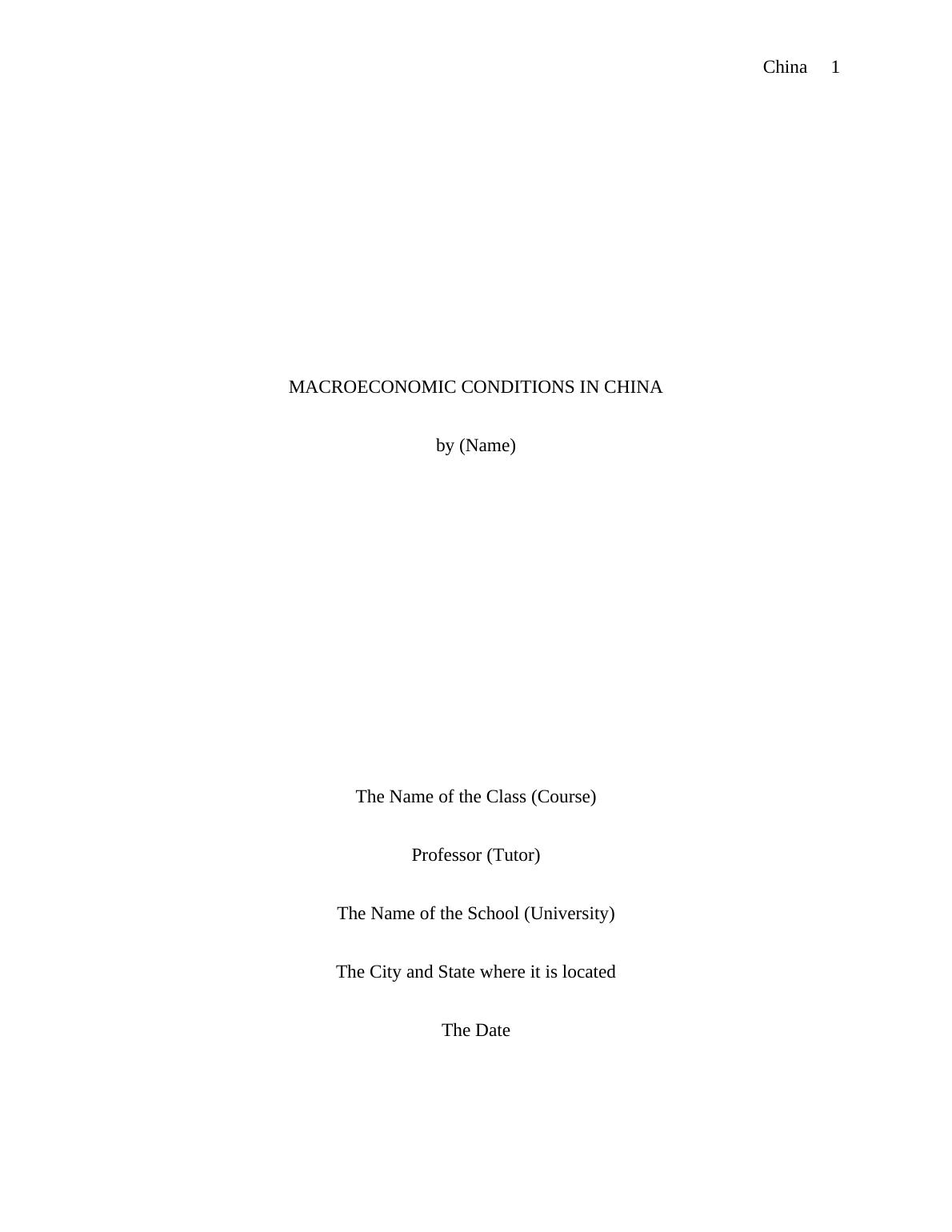
China 2
Abstract
China is one of the most vibrant economies of the world. The country is characterized by a
sustained period of economic growth, low inflation, and stability. As a result of the robustness of
the economy, an Australian based company seeks to invest in the Chinese textile manufacturing
industry. The textile industry in China is the largest in the world and, therefore, is a great
investment opportunity for the Australian firm. Therefore, this paper seeks to analyze the
Macroeconomic environment in China and how it would affect and influence the company’s
long term investment decision. Primarily, the paper is divided into various sections comprising
of an introduction, analysis and discussion, and conclusions and recommendations. The
discussion and analysis section provides an overview and evaluation of macroeconomic variables
such as economic growth and business cycles, unemployment, average wage rate, human capital,
inflation, real interest rate, government expenditure in the economy, and the effects of the Global
financial crisis on the Chinese economy. On the other hand, the conclusion summarized the
discussions in the paper. Lastly, the paper offers various recommendations for the textile firm on
various aspects. All in all, the paper shows that it is a prudent and an economically conscious
decision for the Australian based company to set up a textile manufacturing firm in the Chinese
economy.
Abstract
China is one of the most vibrant economies of the world. The country is characterized by a
sustained period of economic growth, low inflation, and stability. As a result of the robustness of
the economy, an Australian based company seeks to invest in the Chinese textile manufacturing
industry. The textile industry in China is the largest in the world and, therefore, is a great
investment opportunity for the Australian firm. Therefore, this paper seeks to analyze the
Macroeconomic environment in China and how it would affect and influence the company’s
long term investment decision. Primarily, the paper is divided into various sections comprising
of an introduction, analysis and discussion, and conclusions and recommendations. The
discussion and analysis section provides an overview and evaluation of macroeconomic variables
such as economic growth and business cycles, unemployment, average wage rate, human capital,
inflation, real interest rate, government expenditure in the economy, and the effects of the Global
financial crisis on the Chinese economy. On the other hand, the conclusion summarized the
discussions in the paper. Lastly, the paper offers various recommendations for the textile firm on
various aspects. All in all, the paper shows that it is a prudent and an economically conscious
decision for the Australian based company to set up a textile manufacturing firm in the Chinese
economy.
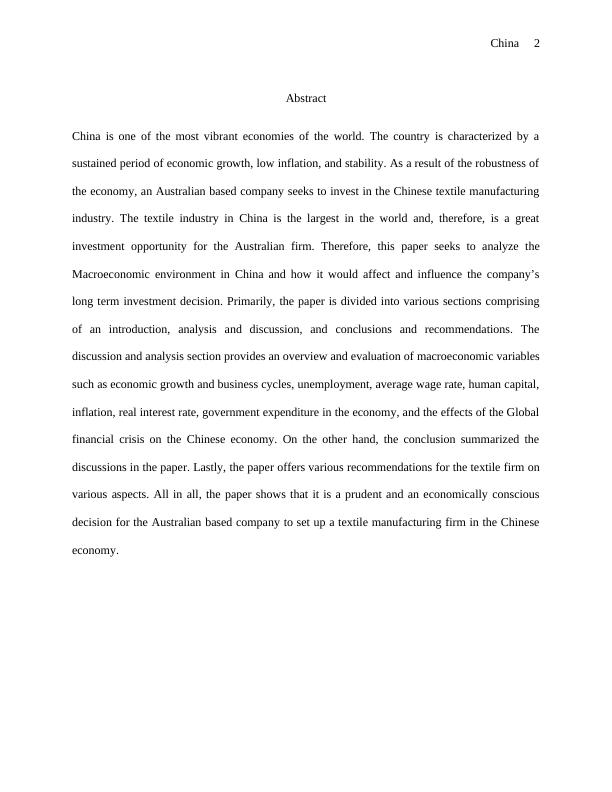
China 3
Contents
1.0 Introduction............................................................................................................... 4
2.0 Macroeconomic Variables and Policies in China..................................................................5
2.1 General Business Environment.................................................................................... 5
2.2 Economic Growth and Business Cycles in China............................................................12
2.3 Unemployment...................................................................................................... 16
2.4 Average Wage Rate................................................................................................ 17
2.5 Human Capital...................................................................................................... 21
2.6 Inflation.............................................................................................................. 22
2.7 Real Interest rate.................................................................................................... 24
2.8 Government Expenditure in the economy.....................................................................25
2.9 Domestic Credit to private sector...............................................................................26
2.10 Effects of Global Financial Crisis in China..................................................................27
3.0 Conclusion.............................................................................................................. 28
3.1 Recommendations..................................................................................................... 29
Macroeconomic Conditions in China
Contents
1.0 Introduction............................................................................................................... 4
2.0 Macroeconomic Variables and Policies in China..................................................................5
2.1 General Business Environment.................................................................................... 5
2.2 Economic Growth and Business Cycles in China............................................................12
2.3 Unemployment...................................................................................................... 16
2.4 Average Wage Rate................................................................................................ 17
2.5 Human Capital...................................................................................................... 21
2.6 Inflation.............................................................................................................. 22
2.7 Real Interest rate.................................................................................................... 24
2.8 Government Expenditure in the economy.....................................................................25
2.9 Domestic Credit to private sector...............................................................................26
2.10 Effects of Global Financial Crisis in China..................................................................27
3.0 Conclusion.............................................................................................................. 28
3.1 Recommendations..................................................................................................... 29
Macroeconomic Conditions in China
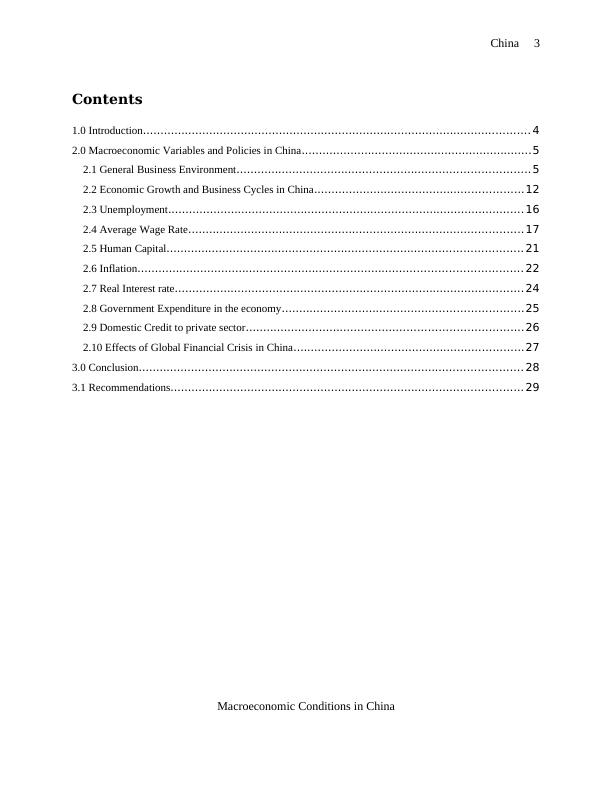
China 4
1.0 Introduction
Today, the Chinese economy is a top three-investment destination. As such, the country
is a popular choice for global institutional investors regardless of the uncertainties in its market
conditions. Over the years, the economy has been experiencing an influx in the level of its
Foreign Direct Investment, something that has significantly led to an increase in its economic
prosperity. In the early 2000s, China overtook the United Stated as the world’s biggest recipient
of foreign capital (World Bank, 2018). Mainly, this is due to the fact that the economy was
favored by conditions in the global capital markets. Also, the nation has a thriving business
economy, a friendly business environment and capital market that attract a lot of foreign
investors into the country. The economy is also an attractive destination for investment due to its
competitiveness. Particularly, the economy has a well developed infrastructure system,
workforce skills, resource availability, and a well developed business value chain. Furthermore,
the country has been experiencing economic and political stability, something that represents
predictability and opportunity for businesses. Additionally, the local Chinese business culture
has helped the economy to evolve, mature and prosper over the past years, making it an attractive
investment destination for foreign companies that wish to invest in the country. What is more,
the country is open to regional and international trade, something that is of critical importance to
businesses (IMF, 2017). Specifically, its export and import friendly policies play a major role in
deciding whether to invest in the country or not. As a whole, the Chinese economy has a great
business environment for both local and foreign organizations, and therefore very favorable for
setting up a textile manufacturing firm by the Australian based company.
1.0 Introduction
Today, the Chinese economy is a top three-investment destination. As such, the country
is a popular choice for global institutional investors regardless of the uncertainties in its market
conditions. Over the years, the economy has been experiencing an influx in the level of its
Foreign Direct Investment, something that has significantly led to an increase in its economic
prosperity. In the early 2000s, China overtook the United Stated as the world’s biggest recipient
of foreign capital (World Bank, 2018). Mainly, this is due to the fact that the economy was
favored by conditions in the global capital markets. Also, the nation has a thriving business
economy, a friendly business environment and capital market that attract a lot of foreign
investors into the country. The economy is also an attractive destination for investment due to its
competitiveness. Particularly, the economy has a well developed infrastructure system,
workforce skills, resource availability, and a well developed business value chain. Furthermore,
the country has been experiencing economic and political stability, something that represents
predictability and opportunity for businesses. Additionally, the local Chinese business culture
has helped the economy to evolve, mature and prosper over the past years, making it an attractive
investment destination for foreign companies that wish to invest in the country. What is more,
the country is open to regional and international trade, something that is of critical importance to
businesses (IMF, 2017). Specifically, its export and import friendly policies play a major role in
deciding whether to invest in the country or not. As a whole, the Chinese economy has a great
business environment for both local and foreign organizations, and therefore very favorable for
setting up a textile manufacturing firm by the Australian based company.

China 5
2.0 Macroeconomic Variables and Policies in China
According to a survey done by the Standard Chartered Bank (2016) the Chinese economy
is among the top three investment destinations in the world. Mainly, this is due to the fact that
the country has been making efforts to open more segments to foreign investors and opening up
to global markets. In addition, China has had a remarkable period of rapid economic growth
shifting from a centrally planned economy to one that is market based. Therefore, the
government fosters a dual economic structure that has evolved from a socialist, centrally planned
economy to one that is largely a socialist market economy. Therefore, this section is going to
provide a critical analysis of the macroeconomic conditions in the country as regards to the
general business environment, economic growth and business cycles, unemployment, average
wage rate, human capital, inflation, real interest rates, government expenditure, taxation policies,
domestic credit to the private sector, exchange rate regimes and fluctuations in the exchange
rates, among others. This section will also discuss two monetary policies in China and the effects
of the Global Financial Crisis to the country’s economy.
2.1 General Business Environment
As a whole, the Chinese economy has a favorable business environment. Mainly, this can be
attributed to the fact that the Chinese government has been working towards making it easier for
foreign companies to invest and establish their operation in the country (China’s Business
Environment, 2017). The opportunities in the country are endless and the market is exceptionally
large. The country’s legal and judicial framework is fair and protects the rights of foreign
investors. Additionally, the requirements for setting up a company in the country are easy and
not complicated or sophisticated as in many other countries.
2.0 Macroeconomic Variables and Policies in China
According to a survey done by the Standard Chartered Bank (2016) the Chinese economy
is among the top three investment destinations in the world. Mainly, this is due to the fact that
the country has been making efforts to open more segments to foreign investors and opening up
to global markets. In addition, China has had a remarkable period of rapid economic growth
shifting from a centrally planned economy to one that is market based. Therefore, the
government fosters a dual economic structure that has evolved from a socialist, centrally planned
economy to one that is largely a socialist market economy. Therefore, this section is going to
provide a critical analysis of the macroeconomic conditions in the country as regards to the
general business environment, economic growth and business cycles, unemployment, average
wage rate, human capital, inflation, real interest rates, government expenditure, taxation policies,
domestic credit to the private sector, exchange rate regimes and fluctuations in the exchange
rates, among others. This section will also discuss two monetary policies in China and the effects
of the Global Financial Crisis to the country’s economy.
2.1 General Business Environment
As a whole, the Chinese economy has a favorable business environment. Mainly, this can be
attributed to the fact that the Chinese government has been working towards making it easier for
foreign companies to invest and establish their operation in the country (China’s Business
Environment, 2017). The opportunities in the country are endless and the market is exceptionally
large. The country’s legal and judicial framework is fair and protects the rights of foreign
investors. Additionally, the requirements for setting up a company in the country are easy and
not complicated or sophisticated as in many other countries.

China 6
Starting a business
For a foreign company to set up a business and operate in China, the firm must analyze
and determine what its options are. Mainly, this is because foreign investors can start and
establish their business in the country in various ways. Specifically, the company can set up as a
Wholly Foreign Owned Enterprise (WFOE), a Partnership Enterprise (PE), a Representative
Office, or a Foreign Invested Partnership Enterprise (FIPE). A wholly Foreign owned enterprise
is a limited liability company that is fully owned by the foreign investor. This company requires
a registered capital and its liability is limited to its equity (Cohen, 2016). It can, therefore,
generate income, pay taxes to the Chinese government. It can also expatriate its profits back to
the investor’s home country. On the other hand, a Representative Office is a liaison office of its
parent company. Thus, it does not need to have a registered capital when being set up in the
country. However, when set up, its activities are limited to product or service promotion, market
research for the parent company, and quality control in liaison with China (Cohen, 2016). Such a
company is prohibited from generating any form of revenue in the country or entering into
contacts with local businesses. The Foreign Invested Partnership Enterprise (FIPE) is a new
concept in the country that entails foreign investors in collaboration with Chinese individuals
starting up a business in the country. Just like a WFOE, this type of enterprise can also generate
revenue, hire local and foreign employees and enter into contracts with local or foreign business.
Therefore, before setting up a business in the country, the company must define the kind of
venture they would like to set up first before registering the business.
Once the firm has determined the most suitable business model to set up, the next step is
to provide documentation from its home country that proves that it is a duly formed and existing
Starting a business
For a foreign company to set up a business and operate in China, the firm must analyze
and determine what its options are. Mainly, this is because foreign investors can start and
establish their business in the country in various ways. Specifically, the company can set up as a
Wholly Foreign Owned Enterprise (WFOE), a Partnership Enterprise (PE), a Representative
Office, or a Foreign Invested Partnership Enterprise (FIPE). A wholly Foreign owned enterprise
is a limited liability company that is fully owned by the foreign investor. This company requires
a registered capital and its liability is limited to its equity (Cohen, 2016). It can, therefore,
generate income, pay taxes to the Chinese government. It can also expatriate its profits back to
the investor’s home country. On the other hand, a Representative Office is a liaison office of its
parent company. Thus, it does not need to have a registered capital when being set up in the
country. However, when set up, its activities are limited to product or service promotion, market
research for the parent company, and quality control in liaison with China (Cohen, 2016). Such a
company is prohibited from generating any form of revenue in the country or entering into
contacts with local businesses. The Foreign Invested Partnership Enterprise (FIPE) is a new
concept in the country that entails foreign investors in collaboration with Chinese individuals
starting up a business in the country. Just like a WFOE, this type of enterprise can also generate
revenue, hire local and foreign employees and enter into contracts with local or foreign business.
Therefore, before setting up a business in the country, the company must define the kind of
venture they would like to set up first before registering the business.
Once the firm has determined the most suitable business model to set up, the next step is
to provide documentation from its home country that proves that it is a duly formed and existing
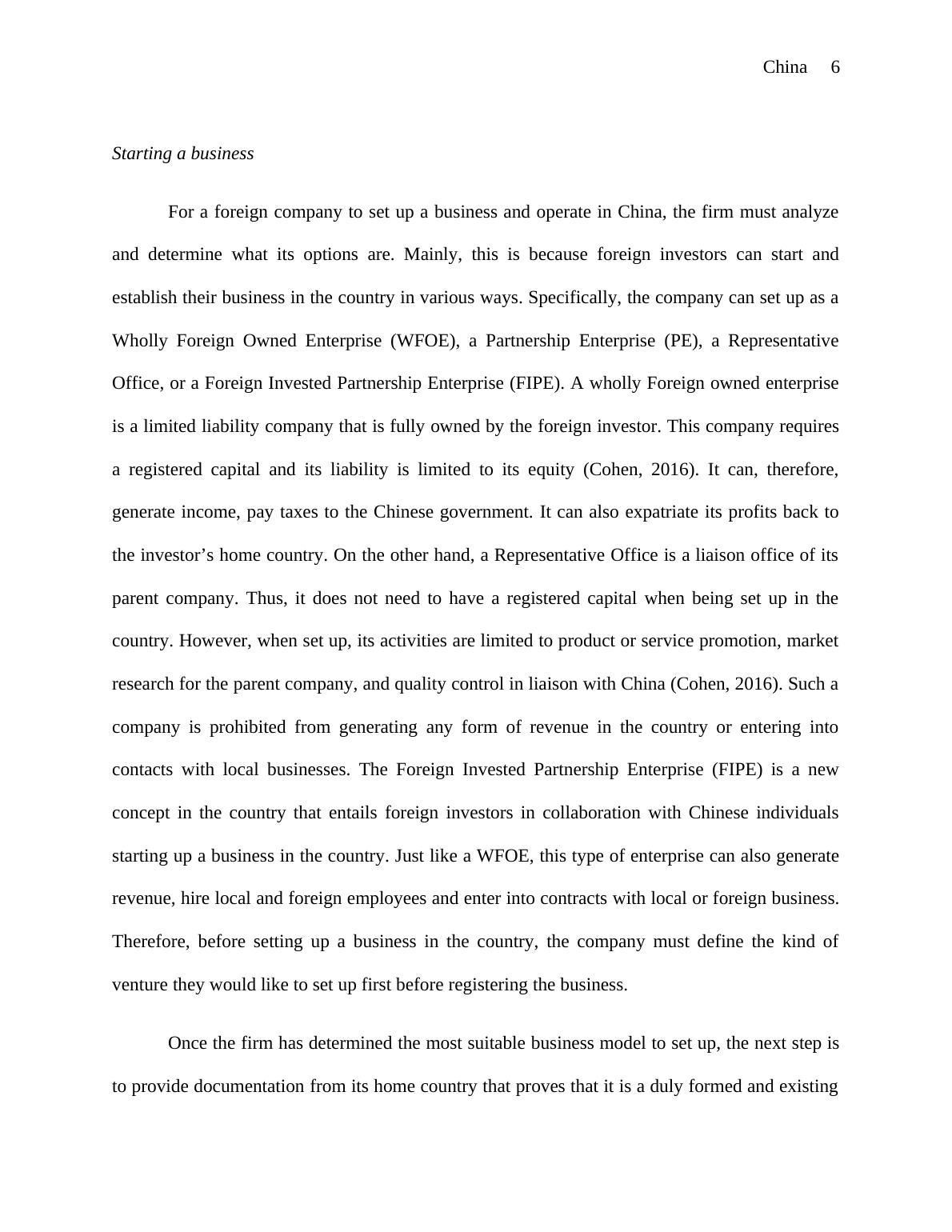
China 7
corporation. The investor must also provide documentation showing the firm’s financial
adequacy in its home country. These documents include the Articles of incorporation, business
license (both local and national), certificate of status, bank letter attesting to the account status of
the firm, and a description of the investor’s business activities alongside materials such as the
annual report, website details and brochures. All these documents are then required for
submission having been translated into Chinese. After submission, what follows is the proof of
ownership. After the proof of ownership has been determined, the company is then required to
seek for the Chinese Government’s approval for the project. It is worth noting that approval by
the relevant government authority is an integral part of the registration process. If the project
fails the approval process, then the company cannot be registered (Business Registration, 2018).
For a WFOE, the company must prepare various documents for approval by the relevant
government authority. They include articles of association, feasibility study, leases, and proposed
personnel salaries. All these documents must be prepared in Chinese. After submission of the
documents, the firm is required to wait for approximately two to three months for governmental
approval. The approval time often depends on the location of the project, its scope as well as its
size. For complex projects, the approval process often involves extensive negotiations with
regulatory authorities before approval.
Dealing with construction permit
After government approval, the firm can proceed with setting up constructions for the business
premises. However, before that, it must go through various processes as prerequisite for
obtaining a construction permit from the authorities. Firstly, the firm must have selected the
industrial zone and contacted to purchase the land which it seeks to develop the business.
corporation. The investor must also provide documentation showing the firm’s financial
adequacy in its home country. These documents include the Articles of incorporation, business
license (both local and national), certificate of status, bank letter attesting to the account status of
the firm, and a description of the investor’s business activities alongside materials such as the
annual report, website details and brochures. All these documents are then required for
submission having been translated into Chinese. After submission, what follows is the proof of
ownership. After the proof of ownership has been determined, the company is then required to
seek for the Chinese Government’s approval for the project. It is worth noting that approval by
the relevant government authority is an integral part of the registration process. If the project
fails the approval process, then the company cannot be registered (Business Registration, 2018).
For a WFOE, the company must prepare various documents for approval by the relevant
government authority. They include articles of association, feasibility study, leases, and proposed
personnel salaries. All these documents must be prepared in Chinese. After submission of the
documents, the firm is required to wait for approximately two to three months for governmental
approval. The approval time often depends on the location of the project, its scope as well as its
size. For complex projects, the approval process often involves extensive negotiations with
regulatory authorities before approval.
Dealing with construction permit
After government approval, the firm can proceed with setting up constructions for the business
premises. However, before that, it must go through various processes as prerequisite for
obtaining a construction permit from the authorities. Firstly, the firm must have selected the
industrial zone and contacted to purchase the land which it seeks to develop the business.

China 8
Secondly, the firm must have received a business license that establishes it as a Chinese
operating company. By this time, the company should have already developed a feasibility study
and a legal person identification (Mitchell, n.d.). Thirdly, the company must have identified,
selected, bid and completed the project design work with an approved Design Institute and have
various supporting documents. These documents include the a copy of the DI qualification letter,
copy of the DIs business license and an approved and notarized copy of the DI contract and
design fee receipt (Mitchell, n.d.). Thirdly, the investing company should also present an
environmental impact report to the relevant authorities. It is also required to have identified,
selected and bid the project construction work with an approved construction company and
possesses copies of the winning bid notification, a copy of the contract with the construction
company, and a certified copy of the construction firm’s business license (Mitchell, n.d.). The
firm is also required to provide a quality monitoring contract. This contract must be with a
separate firm that will oversee the quality of the proposed construction. Alongside these
documents the company must attach the project budget estimate (Mitchell, n.d.).
After the above prerequisite documents have been prepared, the firm can go ahead and
present the required documents for the construction permit to be issued (Mitchell, n.d.). These
documents comprise of details of the project establishment, environmental protection report, site
selection report, land survey and design proposal, land use permit, a construction drawing
review, fire department review, labor and safety review, construction project planning permit,
and a quality monitoring designation (Mitchell, n.d.). Once these documents have been submitted
to the relevant construction authorities and reviewed, the foreign firm can obtain its construction
permit and, can therefore, start the building process.
Secondly, the firm must have received a business license that establishes it as a Chinese
operating company. By this time, the company should have already developed a feasibility study
and a legal person identification (Mitchell, n.d.). Thirdly, the company must have identified,
selected, bid and completed the project design work with an approved Design Institute and have
various supporting documents. These documents include the a copy of the DI qualification letter,
copy of the DIs business license and an approved and notarized copy of the DI contract and
design fee receipt (Mitchell, n.d.). Thirdly, the investing company should also present an
environmental impact report to the relevant authorities. It is also required to have identified,
selected and bid the project construction work with an approved construction company and
possesses copies of the winning bid notification, a copy of the contract with the construction
company, and a certified copy of the construction firm’s business license (Mitchell, n.d.). The
firm is also required to provide a quality monitoring contract. This contract must be with a
separate firm that will oversee the quality of the proposed construction. Alongside these
documents the company must attach the project budget estimate (Mitchell, n.d.).
After the above prerequisite documents have been prepared, the firm can go ahead and
present the required documents for the construction permit to be issued (Mitchell, n.d.). These
documents comprise of details of the project establishment, environmental protection report, site
selection report, land survey and design proposal, land use permit, a construction drawing
review, fire department review, labor and safety review, construction project planning permit,
and a quality monitoring designation (Mitchell, n.d.). Once these documents have been submitted
to the relevant construction authorities and reviewed, the foreign firm can obtain its construction
permit and, can therefore, start the building process.
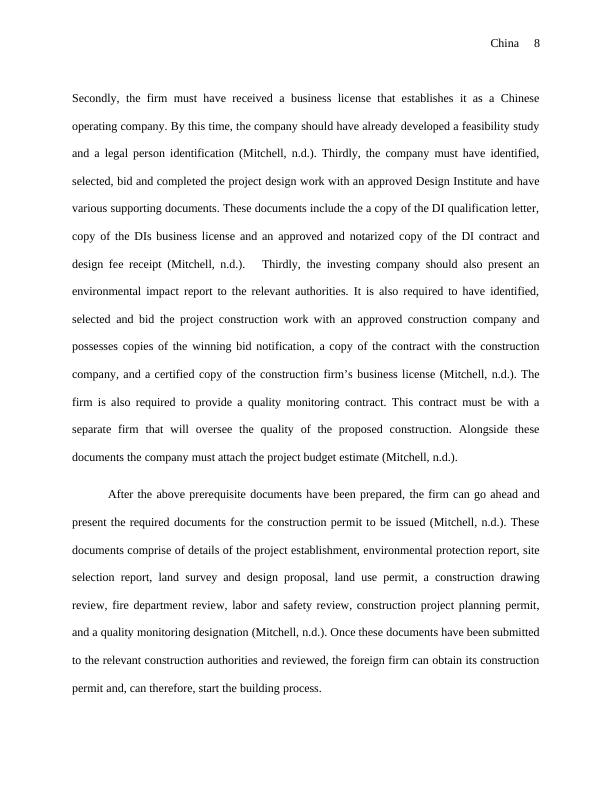
End of preview
Want to access all the pages? Upload your documents or become a member.
Related Documents
Macroeconomics and Long Term Investment in a Nationlg...
|41
|10685
|409
Macroeconomics Assignment | Economics Assignmentlg...
|32
|6992
|56
Paper on the Importance of Different Macro Variableslg...
|44
|9608
|63
(PDF) Changing Scenario of India's Business Environmentlg...
|27
|8116
|33
Role of Fiscal Policy in Stabilizing the Australian Economylg...
|20
|3091
|45
Macroeconomics Assignment: Article Analysislg...
|16
|2927
|338
